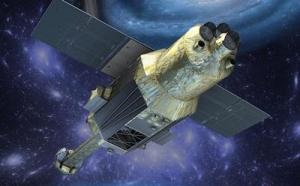Nov 17 2017
Data captured by a ‘lost’ satellite mission involving the University of Southampton has provided scientists with vital information about gases in a galaxy cluster 240 million light years from Earth.
 The Hitomi X-ray satellite (Credit: University of Southampton)
The Hitomi X-ray satellite (Credit: University of Southampton)
The Japanese Hitomi X-ray satellite, developed jointly by NASA and the Japan Aerospace Exploration Agency (JAXA), has given astronomers an important insight into the Perseus galaxy cluster – a collection of thousands of galaxies orbiting within a thin hot gas, all bound together by gravity.
The Hitomi mission came to an abrupt end because of problems with its altitude control system, but the data it captured during its 38 days in space has allowed scientists to analyse the composition of the Perseus gases and gain a deeper understanding of the stellar explosions that created them.
The gas in the Perseus cluster averages 90 million degrees Fahrenheit (50 million degrees Celsius) and is the source of the cluster’s X-ray emission.
Using Hitomi’s high-resolution Soft X-ray Spectrometer (SXS) instrument, researchers observed the cluster between 25 February and 6 March, 2016, acquiring a total exposure of nearly 3.4 days.
The SXS observed an unprecedented spectrum, revealing a landscape of X-ray peaks emitted from various chemical elements with a resolution some 30 times better than previously seen.
In a paper published online in the journal Nature, researchers show that the proportions of elements found in the cluster are nearly identical to what astronomers see in our Sun.
One group of elements is closely tied to a particular class of stellar explosion, called Type Ia supernovas. These explosions entail the total destruction of a white dwarf, a compact remnant produced by stars like the Sun.
These blasts are thought to be responsible for producing most of the Universe's chromium, manganese, iron and nickel — metals collectively known as ‘iron-peak’ elements.
The study suggests that the same combination of Type Ia supernovas producing iron-peak elements in our solar system also produced these metals in the cluster’s gas.
This means both the solar system and the Perseus cluster experienced broadly similar chemical evolution, suggesting that the processes forming stars – and the systems that became Type Ia supernovas – were comparable in both locations.
University of Southampton astronomer Dr Poshak Gandhi, who was among a 200-strong team of scientists involved in the international collaboration, said: “Despite the failure of the mission soon after launch, the precious few observations that we did obtain have proven to be transformational for our understanding of superheated cosmic plasmas.
“Such plasmas outweigh known galaxies in clusters 10 to one, so are an essential component to our complete understanding of the Universe.
“The present study is just a glimpse of how much more remains to be learnt. And this is – almost – within our grasp. JAXA and NASA are planning to launch a follow-up X-ray observatory, together with the European Space Agency. I sincerely hope that the UK will be able to participate in this mission and to reap the rewards of opening up new frontiers in X-ray astronomy.”
The science in the new study was driven by the international Hitomi team, especially Hiroya Yamaguchi of NASA and Kyoko Matsushita of the Tokyo University of Science.